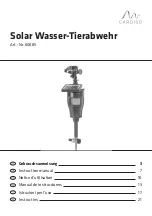
10
Testing was performed under standard laboratory conditions, actual performance may vary.
This system is acceptable for treatment of influent concentrations of no more than 27 mg/L nitrate and 3 mg/L nitrite
(In combination measured as N), and is contingent on the proper functioning of the booster pump included as part of
this system to deliver a minimum pressure on the membrane of at least 40 psi.
This system has been tested for the treatment of water containing pentavalent arsenic (also known as As (V), As (+5),
or arsenate) at concentrations of [0.050 mg/L or 0.30 mg/L] or less. This system reduces pentavalent arsenic but may
not remove other forms of arsenic. This system is to be used on water supplies containing detectable free chlorine
residual or on water supplies that have been demonstrated to contain only pentavalent arsenic. Treatment with
chloramines (combined chlorine) is not sufficient to ensure complete conversion of trivalent arsenic to pentavalent
arsenic. Please see the Arsenic Facts section of the performance data sheet for further information.
Arsenic (As) is a naturally occurring contaminant found in many ground waters. It generally occurs in two forms
(valences or oxidation states): pentavalent arsenic (also known as As(V), As(+5), or arsenate) and trivalent arsenic
(also known as As(III), As(+3), or arsenite). In natural ground water, arsenic may exist as trivalent arsenic, pentavalent
arsenic, or a combination of both. Although both forms of arsenic are potentially harmful to human health, trivalent
arsenic is considered more harmful than pentavalent arsenic. More information about arsenic and its toxicity can be
found on the U.S. Environmental Protection Agency website at http://www.epa.gov/safewater/arsenic.html.
This system is designed to remove only pentavalent arsenic. This treatment system does not provide a feature for
conversion of trivalent arsenic to pentavalent arsenic. The system may remove some trivalent arsenic, however, it has
not been evaluated for its ability to remove trivalent arsenic.
Trivalent arsenic is generally more difficult to remove from drinking water than pentavalent arsenic. Trivalent arsenic
can be converted to pentavalent arsenic in the presence of an effective oxidant such as free chlorine. The arsenic in
water containing detectable free chlorine or that has been treated with another effective oxidant will be in the
pentavalent arsenic form.4 Treatment with chloramine (combined chlorine) is not sufficient to ensure complete
conversion of trivalent arsenic to pentavalent arsenic.
Consumers using public water supplies can contact their utility to verify whether free chlorine treatment chemicals are
being used. Private water supplies and waters that do not have detectable free chlorine residuals should be analyzed
to determine the form(s) of arsenic present and the potential need for oxidation of trivalent arsenic to pentavalent
arsenic.
Arsenic does not generally impart color, taste, or smell to water, therefore, it can only be detected by a chemical
analytical test. Public water supplies are required to monitor treated water for total arsenic (trivalent arsenic plus
pentavalent arsenic) and the results are available to the public from the utility. Consumers using private water sources
will need to make arrangements for testing. A total arsenic test usually costs about $15-$30 and it is recommended the
test be conducted by a certified laboratory. Local health departments or environmental protection agencies can help
provide consumers with a list of certified laboratories. Some laboratories may also be able to analyze specifically for
(speciate) the form(s) of arsenic present in a water sample if requested.
This treatment system was tested under laboratory conditions as defined in NSF/ANSI 58 Drinking Water Treatment
Units – Health Effects and was found to reduce 0.30 mg/L of pentavalent arsenic in the test water to less than 0.010
mg/L under standard testing conditions. Actual performance of the system may vary depending on specific water
quality conditions at the consumer's installation. Following installation of this system, the consumer should have the
treated water tested for total arsenic to verify arsenic reduction is being achieved and the system is functioning
properly.
The arsenic removal component of this system must be replaced at the end of its useful life of 1-2 years. The
replacement component, 20008 SP Inline Sediment Filter 10", 20009 SP Inline Carbon Filter 8", 20001 SP RO
Membrane Welded 10" Housing, 20015 SP Post Carbon Filter (Blue), 20003 SP Hollow Fibre Membrane (RO) and
can be purchased directly from the manufacturer Kent RO Systems. Ltd.
Arsenic Facts
20020 SP FRT 300
Do not use with water that is microbiological
nknown quality w/o adequate disinfection before or after
the system.
Efficiency rating means the percentage of the influent water that is available to the user as reverse osmosis treated
water under operating condition that approximate typical daily usage.
ly unsafe or of u
9



























